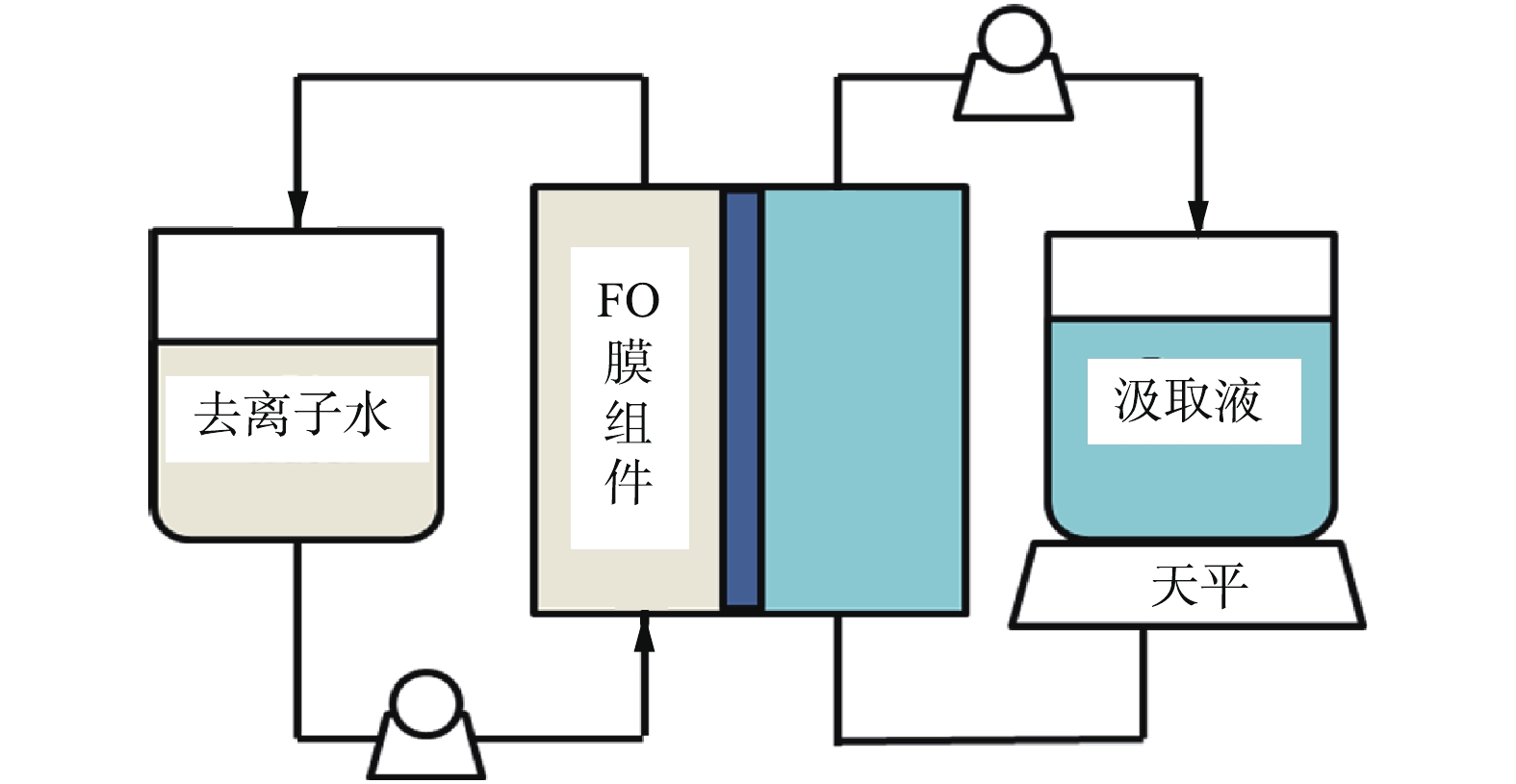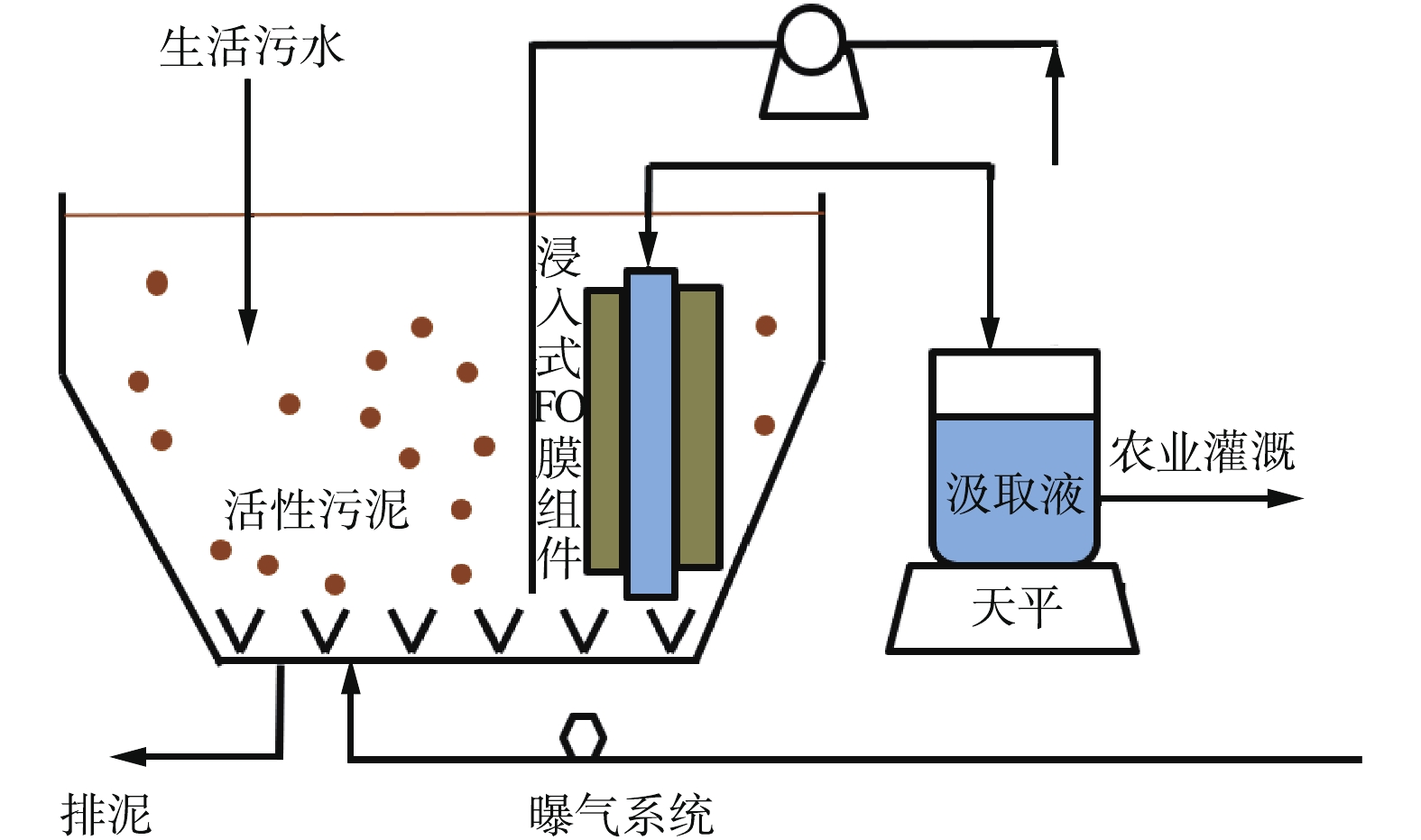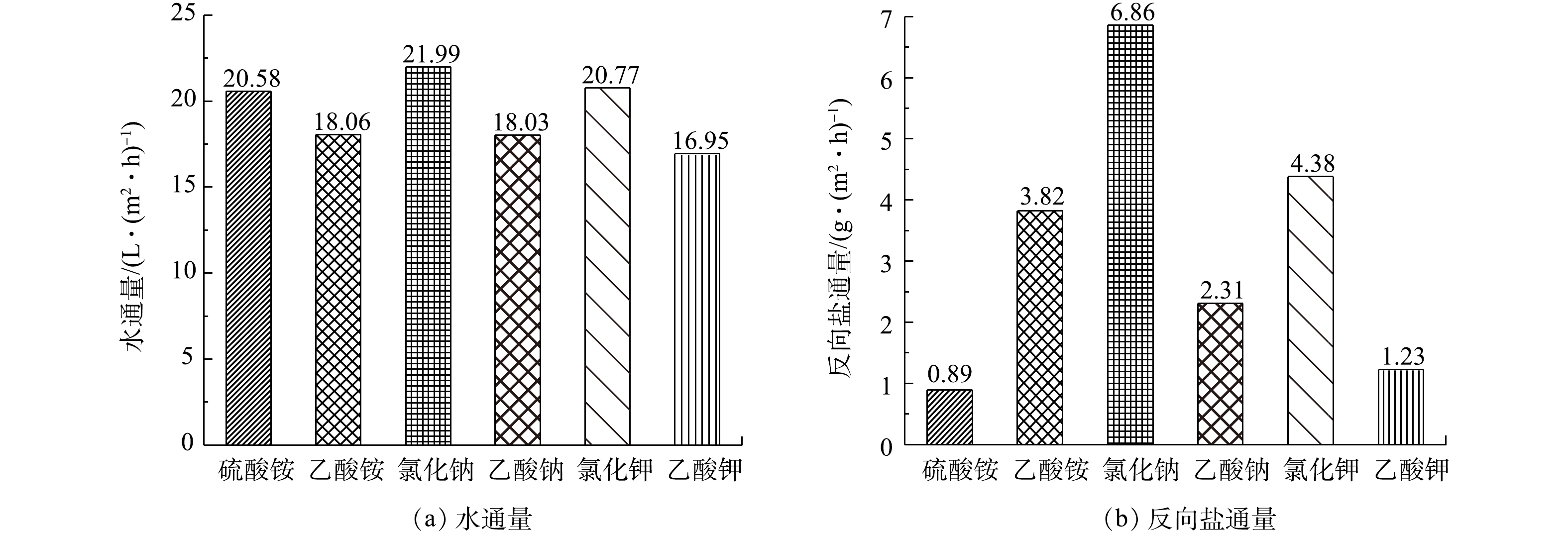2.悉尼科技大学市政与环境工程学院,悉尼 NSW2007
1.State Environmental Protection Engineering Center for Pollution Treatment and Control in Textile Industry, School of Environmental Science and Technology, Donghua University, Shanghai 201620, China
2.School of Civil and Environmental Engineering, University of Technology Sydney, NSW 2007, Australia
)、氯化钠(NaCl)和氯化钾(KCl) 3种其对应无机离子汲取液的正渗透(FO)工艺性能和正渗透膜生物反应器(OMBR)工艺性能进行比较。通过工艺水通量和盐含量的测定,生物反应器内COD、铵态氮和硝态氮含量的测定,污染后膜表面的SEM分析,评价了基于乙酸根离子的有机化肥作为正渗透膜反应器的汲取液对反应器内盐积累和膜污染的影响。结果表明:在FO工艺中,乙酸铵、乙酸钠和乙酸钾在0.6 mol·L
,低于其对应的无机离子汲取液的水通量;在OMBR工艺中,乙酸铵、乙酸钠和乙酸钾有机化肥作为汲取液可以显著减缓反应器内盐度的积累。此外,当基于乙酸根离子的有机化肥作为正渗透膜反应器的汲取液时,生物反应器中微生物的生物活性更高,虽然这更容易造成膜污染,但可以有效地去除有机物和氮磷营养物质。研究可为正渗透生物反应器的实际应用提供参考。
To solve the problem of salt accumulation in the forward osmosis membrane bioreactor, the performances of forward osmosis (FO) and osmosis membrane bio-reactor (OMBR) with three ionic organic draw solutes, ammonium acetate (NH
) were investigated in this study, which were also compared with those of FO and OMBR with three inorganic draw solutes: ammonium sulfate ((NH
), sodium chloride (NaCl) and potassium chloride (KCl). Water flux and salt concentration were measured for comparing the performance of the different draw solutes, COD, ammonium and nitrate concentration were measured to evaluate the biodegradability in the bioreactor. The fouled membrane surface was analyzed by SEM. Results show that the average water fluxes of FO were 10.30, 11.07 and 12.73 L·(m
concentration ammonium acetate, sodium acetate and potassium acetate, respectively, which were lower than those with the inorganic draw solutes. In OMBR process, the ionic organic draw solution could significantly reduce salt accumulation. In addition, when organic fertilizer based on acetate-based ions was used as the draw solution, the biological activity of microorganisms was higher than inorganic fertilizer draw solution, the former could lead to effective removal of organics and nutrients by OMBR though it was easier to form membrane fouling. This study can provide a reference for OMBR practical application.
.
Schematic diagram of bench-scale FO system
Schematic diagram of bench-scale OMBR system
Comparison of FO performance with different draw solutions
Change of water flux of OMBR with different draw solutions
Salt accumulation in OMBR with the different draw solutions
COD removing efficiency of OMBR with different draw solutions
concentrations of different draw solutions in OMBR
Membrane fouling surface after 4 d experiments
SEM images of membrane surface before and after fouling
| [1] | ACHILLI A, CATH T Y, CHILDRESS A E. Selection of inorganic-based draw solutions for forward osmosis applications[J]. Journal of Membrane Science, 2010, 364: 233-241. doi: 10.1016/j.memsci.2010.08.010 |
| [2] | ACHILLI A, CATH T Y, MARCHAND E A, et al. The forward osmosis membrane bioreactor: A low fouling alternative to MBR processes[J]. Desalination, 2009, 239: 10-21. doi: 10.1016/j.desal.2008.02.022 |
| [3] | ALTURKI A, MCDONALD J, KHAN S J, et al. Performance of a novel osmotic membrane bioreactor (OMBR) system: Flux stability and removal of trace organics[J]. Bioresource Technology, 2012, 113: 201-206. doi: 10.1016/j.biortech.2012.01.082 |
| [4] | ANSARI A J, HAI F I, GUO W, et al. Factors governing the pre-concentration of wastewater using forward osmosis for subsequent resource recovery[J]. Science of the Total Environment, 2016, 566-567: 559-566. doi: 10.1016/j.scitotenv.2016.05.139 |
| [5] | ANSARI A J, HAI F I, PRICE W E, et al. Forward osmosis as a platform for resource recovery from municipal wastewater: A critical assessment of the literature[J]. Journal of Membrane Science, 2017, 529: 195-206. doi: 10.1016/j.memsci.2017.01.054 |
| [6] | BAKER J S, DUDLEY L Y. Biofouling in membrane systems: A review[J]. Desalination, 1998, 118: 81-89. doi: 10.1016/S0011-9164(98)00091-5 |
| [7] | BOWDEN K S, ACHILLI A, CHILDRESS A E. Organic ionic salt draw solutions for osmotic membrane bioreactors[J]. Bioresource Technology, 2012, 122: 207-216. doi: 10.1016/j.biortech.2012.06.026 |
| [8] | CATH T, CHILDRESS A, ELIMELECH M. Forward osmosis: Principles, applications, and recent developments[J]. Journal of Membrane Science, 2006, 281: 70-87. doi: 10.1016/j.memsci.2006.05.048 |
| [9] | CHEKLI L, KIM J E, SALIBY I E, et al. Fertilizer drawn forward osmosis process for sustainable water reuse to grow hydroponic lettuce using commercial nutrient solution[J]. Separation & Purification Technology, 2017, 181: 18-28. |
| [10] | CHEKLI L, PHUNTSHO S, KIM J E, et al. A comprehensive review of hybrid forward osmosis systems: Performance, applications and future prospects[J]. Journal of Membrane Science, 2015, 497: 430-449. |
| [11] | CHOU S, LEI S, RONG W, et al. Characteristics and potential applications of a novel forward osmosis hollow fiber membrane[J]. Desalination, 2010, 261: 365-372. doi: 10.1016/j.desal.2010.06.027 |
| [12] | CHUNG T S, LI X, ONG R C, et al. Emerging forward osmosis (FO) technologies and challenges ahead for clean water and clean energy applications[J]. Current Opinion in Chemical Engineering, 2012, 1(3): 246-257. doi: 10.1016/j.coche.2012.07.004 |
| [13] | CHUNG T S, ZHANG S, WANG K Y, et al. Forward osmosis processes: Yesterday, today and tomorrow[J]. Desalination, 2012, 287: 78-81. doi: 10.1016/j.desal.2010.12.019 |
| [14] | LI S, KIM Y, PHUNTSHO S, et al. Methane production in an anaerobic osmotic membrane bioreactor using forward osmosis: Effect of reverse salt flux[J]. Bioresource Technology, 2017, 239: 285-293. doi: 10.1016/j.biortech.2017.05.044 |
| [15] | GE Q, LING M, CHUNG T S. Draw solutions for forward osmosis processes: Developments, challenges, and prospects for the future[J]. Journal of Membrane Science, 2013, 442: 225-237. doi: 10.1016/j.memsci.2013.03.046 |
| [16] | GULYAS H, REICH M, OTTERPOHL R. Organic micropollutants in raw and treated greywater: A preliminary investigation[J]. Urban Water Journal, 2011, 8(1): 29-39. doi: 10.1080/1573062X.2010.528435 |
| [17] | HOINKIS J. Membrane bioreactors for water treatment[J]. Advances in Membrane Technologies for Water Treatment, 2015, 3: 155-184. |
| [18] | HOLLOWAY R W, CHILDRESS A E, DENNETT K E, et al. Forward osmosis for concentration of anaerobic digester centrate[J]. Water Research, 2007, 41: 4005-4014. doi: 10.1016/j.watres.2007.05.054 |
| [19] | HOLLOWAY R W, REGNERY J, NGHIEM L D, et al. Removal of trace organic chemicals and performance of a novel hybrid ultrafiltration-osmotic membrane bioreactor[J]. Environmental Science & Technology, 2014, 48: 10859-10868. |
| [20] | HOLLOWAY R W, WAIT A S, FERNANDES DA SILVA A, et al. Long-term pilot scale investigation of novel hybrid ultrafiltration-osmotic membrane bioreactors[J]. Desalination, 2015, 363: 64-74. doi: 10.1016/j.desal.2014.05.040 |
| [21] | KAWASAKI K, MARUOKA S, KATAGAMI R, et al. Effect of initial MLSS on operation of submerged membrane activated sludge process[J]. Desalination, 2011, 281: 334-339. doi: 10.1016/j.desal.2011.08.013 |
| [22] | KIM Y, CHEKLI L, SHIM W G, et al. Selection of suitable fertilizer draw solute for a novel fertilizer-drawn forward osmosis-anaerobic membrane bioreactor hybrid system[J]. Bioresource Technology, 2016, 210: 26-34. doi: 10.1016/j.biortech.2016.02.019 |
| [23] | LAY W C L, ZHANG Q, ZHANG J, et al. Study of integration of forward osmosis and biological process: Membrane performance under elevated salt environment[J]. Desalination, 2011, 283: 123-130. doi: 10.1016/j.desal.2011.01.036 |
| [24] | LUO W, HAI F I, KANG J, et al. Effects of salinity build-up on biomass characteristics and trace organic chemical removal: Implications on the development of high retention membrane bioreactors[J]. Bioresource Technology, 2015, 177: 274-281. doi: 10.1016/j.biortech.2014.11.084 |
| [25] | MCCUTCHEON J R, ELIMELECH M. Influence of concentrative and dilutive internal concentration polarization on flux behavior in forward osmosis[J]. Journal of Membrane Science, 2006, 284: 237-247. doi: 10.1016/j.memsci.2006.07.049 |
| [26] | PATHAK N, CHEKLI L, WANG J, et al. Performance of a novel baffled osmotic membrane bioreactor-microfiltration hybrid system under continuous operation for simultaneous nutrient removal and mitigation of brine discharge[J]. Bioresource Technology, 2017, 240: 50-58. doi: 10.1016/j.biortech.2017.03.069 |
| [27] | PHUNTSHO S, HONG S, ELIMELECH M, et al. Forward osmosis desalination of brackish groundwater: Meeting water quality requirements for fertigation by integrating nanofiltration[J]. Journal of Membrane Science, 2013, 436: 1-15. doi: 10.1016/j.memsci.2013.02.022 |
| [28] | PHUNTSHO S, SHON H K, HONG S, et al. A novel low energy fertilizer driven forward osmosis desalination for direct fertigation: Evaluating the performance of fertilizer draw solutions[J]. Journal of Membrane Science, 2011, 375: 172-181. doi: 10.1016/j.memsci.2011.03.038 |
| [29] | PHUNTSHO S, SHON H K, MAJEED T, et al. Blended fertilizers as draw solutions for fertilizer-drawn forward osmosis desalination[J]. Environmental Science & Technology, 2012, 46: 4567-4575. |
| [30] | QIU G, TING Y P. Osmotic membrane bioreactor for wastewater treatment and the effect of salt accumulation on system performance and microbial community dynamics[J]. Bioresource Technology, 2013, 150: 287-297. doi: 10.1016/j.biortech.2013.09.090 |
| [31] | SHE Q, WANG R, FANE A G, et al. Membrane fouling in osmotically driven membrane processes: A review[J]. Journal of Membrane Science, 2016, 499: 201-233. doi: 10.1016/j.memsci.2015.10.040 |
| [32] | WANG J, PATHAK N, CHEKLI L, et al. Performance of a novel fertilizer-drawn forward osmosis aerobic membrane bioreactor (FDFO-MBR): Mitigating salinity build-up by integrating microfiltration[J]. Water, 2017, 9: 21. doi: 10.3390/w9010021 |
| [33] | WANG X, YUAN B, CHEN Y, et al. Integration of micro-filtration into osmotic membrane bioreactors to prevent salinity build-up[J]. Bioresource Technology, 2014, 167: 116-123. doi: 10.1016/j.biortech.2014.05.121 |
| [34] | XIE M, SHON H K, GRAY S R, et al. Membrane-based processes for wastewater nutrient recovery: Technology, challenges, and future direction[J]. Water Research, 2015, 89: 210-221. |


 下载:
下载: 







 点击查看大图
点击查看大图